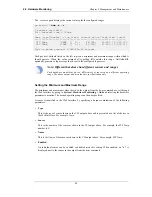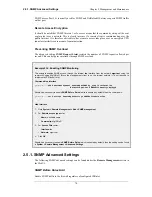
This example adds a range of IP addresses from 192.168.10.16 to 192.168.10.21 and names the range
wwwservers:
Command-Line Interface
gw-world:/> add Address IP4Address wwwservers
Address=192.168.10.16-192.168.10.21
Web Interface
1.
Go to Objects > Address Book > Add > IP address
2.
Specify a suitable name for the IP Range, for example wwwservers.
3.
Enter 192.168.10.16-192.168.10.21 as the IP Address
4.
Click OK
Example 3.4. Deleting an Address Object
To delete an object named wwwsrv1 in the address book, do the following:
Command-Line Interface
gw-world:/> delete Address IP4Address wwwsrv1
Web Interface
1.
Go to Objects > Address Book
2.
Select the address object wwwsrv1
3.
Choose Delete from the menu
4.
Click OK
Deleting In-use IP Objects
If an IP object is deleted that is in use by another object then NetDefendOS will not allow the
configuration to be deployed and will produce a warning message. In other words, it will appear that
the object has been successfully deleted but NetDefendOS will not allow the configuration to be
saved to the NetDefend Firewall.
3.1.3. Ethernet Addresses
Ethernet Address objects are used to define symbolic names for Ethernet addresses (also known as
MAC addresses). This is useful, for example, when populating the ARP table with static ARP
entries, or for other parts of the configuration where symbolic names are preferred over numerical
Ethernet addresses.
When specifying an Ethernet address the format aa-bb-cc-dd-ee-ff should be used. Ethernet
addresses are also displayed using this format.
Example 3.5. Adding an Ethernet Address
3.1.3. Ethernet Addresses
Chapter 3. Fundamentals
82
Summary of Contents for DFL-1600 - Security Appliance
Page 27: ...1 3 NetDefendOS State Engine Packet Flow Chapter 1 NetDefendOS Overview 27 ...
Page 79: ...2 7 3 Restore to Factory Defaults Chapter 2 Management and Maintenance 79 ...
Page 146: ...3 9 DNS Chapter 3 Fundamentals 146 ...
Page 227: ...4 7 5 Advanced Settings for Transparent Mode Chapter 4 Routing 227 ...
Page 241: ...5 4 IP Pools Chapter 5 DHCP Services 241 ...
Page 339: ...6 7 Blacklisting Hosts and Networks Chapter 6 Security Mechanisms 339 ...
Page 360: ...7 4 7 SAT and FwdFast Rules Chapter 7 Address Translation 360 ...
Page 382: ...8 3 Customizing HTML Pages Chapter 8 User Authentication 382 ...
Page 386: ... The TLS ALG 9 1 5 The TLS Alternative for VPN Chapter 9 VPN 386 ...
Page 439: ...Figure 9 3 PPTP Client Usage 9 5 4 PPTP L2TP Clients Chapter 9 VPN 439 ...
Page 450: ...9 7 6 Specific Symptoms Chapter 9 VPN 450 ...
Page 488: ...10 4 6 Setting Up SLB_SAT Rules Chapter 10 Traffic Management 488 ...
Page 503: ...11 6 HA Advanced Settings Chapter 11 High Availability 503 ...
Page 510: ...12 3 5 Limitations Chapter 12 ZoneDefense 510 ...
Page 533: ...13 9 Miscellaneous Settings Chapter 13 Advanced Settings 533 ...
















































